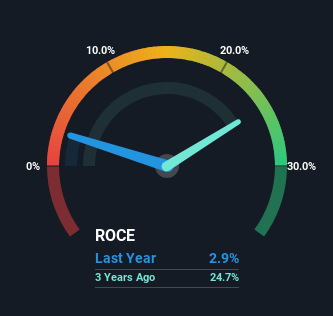There Are Reasons To Feel Uneasy About Xinlei Compressor's (SZSE:301317) Returns On Capital

What are the early trends we should look for to identify a stock that could multiply in value over the long term? Amongst other things, we'll want to see two things; firstly, a growing return on capital employed (ROCE) and secondly, an expansion in the company's amount of capital employed. Ultimately, this demonstrates that it's a business that is reinvesting profits at increasing rates of return. In light of that, when we looked at Xinlei Compressor (SZSE:301317) and its ROCE trend, we weren't exactly thrilled.
Understanding Return On Capital Employed (ROCE)
For those that aren't sure what ROCE is, it measures the amount of pre-tax profits a company can generate from the capital employed in its business. Analysts use this formula to calculate it for Xinlei Compressor:
Return on Capital Employed = Earnings Before Interest and Tax (EBIT) ÷ (Total Assets - Current Liabilities)
0.029 = CN¥37m ÷ (CN¥1.9b - CN¥624m) (Based on the trailing twelve months to September 2023).
So, Xinlei Compressor has an ROCE of 2.9%. Ultimately, that's a low return and it under-performs the Machinery industry average of 6.0%.
See our latest analysis for Xinlei Compressor

While the past is not representative of the future, it can be helpful to know how a company has performed historically, which is why we have this chart above. If you're interested in investigating Xinlei Compressor's past further, check out this free graph covering Xinlei Compressor's past earnings, revenue and cash flow.
How Are Returns Trending?
When we looked at the ROCE trend at Xinlei Compressor, we didn't gain much confidence. Over the last four years, returns on capital have decreased to 2.9% from 17% four years ago. Given the business is employing more capital while revenue has slipped, this is a bit concerning. This could mean that the business is losing its competitive advantage or market share, because while more money is being put into ventures, it's actually producing a lower return - "less bang for their buck" per se.
On a side note, Xinlei Compressor has done well to pay down its current liabilities to 33% of total assets. So we could link some of this to the decrease in ROCE. Effectively this means their suppliers or short-term creditors are funding less of the business, which reduces some elements of risk. Some would claim this reduces the business' efficiency at generating ROCE since it is now funding more of the operations with its own money.
Our Take On Xinlei Compressor's ROCE
We're a bit apprehensive about Xinlei Compressor because despite more capital being deployed in the business, returns on that capital and sales have both fallen. Investors haven't taken kindly to these developments, since the stock has declined 32% from where it was year ago. With underlying trends that aren't great in these areas, we'd consider looking elsewhere.
One final note, you should learn about the 3 warning signs we've spotted with Xinlei Compressor (including 1 which is a bit unpleasant) .
While Xinlei Compressor may not currently earn the highest returns, we've compiled a list of companies that currently earn more than 25% return on equity. Check out this free list here.
New: AI Stock Screener & Alerts
Our new AI Stock Screener scans the market every day to uncover opportunities.
• Dividend Powerhouses (3%+ Yield)
• Undervalued Small Caps with Insider Buying
• High growth Tech and AI Companies
Or build your own from over 50 metrics.
Have feedback on this article? Concerned about the content? Get in touch with us directly. Alternatively, email editorial-team (at) simplywallst.com.
This article by Simply Wall St is general in nature. We provide commentary based on historical data and analyst forecasts only using an unbiased methodology and our articles are not intended to be financial advice. It does not constitute a recommendation to buy or sell any stock, and does not take account of your objectives, or your financial situation. We aim to bring you long-term focused analysis driven by fundamental data. Note that our analysis may not factor in the latest price-sensitive company announcements or qualitative material. Simply Wall St has no position in any stocks mentioned.
About SZSE:301317
Xinlei Compressor
Engages in the research and development, manufacture, and sale of air compressors and blowers in China.
Solid track record with mediocre balance sheet.
Market Insights
Community Narratives


